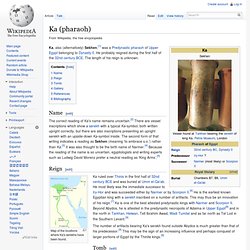

Anubis on the job by ~ServerusTare. Ancient Egypt. Ancient Egypt was an ancient civilization of Northeastern Africa, concentrated along the lower reaches of the Nile River in what is now the modern country of Egypt.

It is one of six civilizations globally to arise independently. Egyptian civilization coalesced around 3150 BC (according to conventional Egyptian chronology)[1] with the political unification of Upper and Lower Egypt under the first pharaoh.[2] The history of ancient Egypt occurred in a series of stable Kingdoms, separated by periods of relative instability known as Intermediate Periods: the Old Kingdom of the Early Bronze Age, the Middle Kingdom of the Middle Bronze Age and the New Kingdom of the Late Bronze Age.
History Map of ancient Egypt, showing major cities and sites of the Dynastic period (c. 3150 BC to 30 BC) Predynastic period A typical Naqada II jar decorated with gazelles. In Predynastic and Early Dynastic times, the Egyptian climate was much less arid than it is today. Early Dynastic Period (c. 3050 –2686 BC)
Ka (pharaoh) Ka, also (alternatively) Sekhen,[1] was a Predynastic pharaoh of Upper Egypt belonging to Dynasty 0.

He probably reigned during the first half of the 32nd century BCE. The length of his reign is unknown. The correct reading of Ka's name remains uncertain. There are vessel inscriptions which show a serekh with a typical Ka-symbol, both written upright correctly, but there are also inscriptions presenting an upright serekh with an upside-down Ka-symbol inside.
The second form of that writing indicates a reading as Sekhen (meaning ‘to embrace s.o.’) rather than Ka.[3] It was also thought to be the birth name of Narmer.[4] Because the reading of the name is so uncertain, egyptologists and writing experts such as Ludwig David Morenz prefer a neutral reading as ‘King Arms’.[5] Map of the locations where Ka's serekhs have been found. Two underground chambers, B7 and B9, in the Umm el-Qa'ab necropolis of Abydos are believed to be part of the tomb of king Ka. Seal impression with Ka's serekh. King Scorpion. Scorpion II (Ancient Egyptian: possibly Selk or Weha[1]), also known as King Scorpion, refers to the second of two kings or chieftains of that name during the Protodynastic Period of Upper Egypt.

Identity Name The scorpion fetish, which underlies the name of Scorpion II, is generally linked to the later-introduced goddess Selket. But Egyptologists and linguists such as L.D. Morenz, H. Historical figure Attestations Macehead Head of king Scorpion on his mace head. Narmer. The identity of Narmer is the subject of ongoing debate, although mainstream Egyptological consensus[2][3][4] identifies Narmer with the First Dynasty pharaoh Menes.

Menes is also credited with the unification of Egypt, as the first pharaoh. This conclusion is based on the Narmer Palette which shows Narmer as the unifier of Egypt and the two necropolis seals from the necropolis of Abydos that show him as the first king of the First Dynasty (see discussion below). Reign[edit] City of the Dead (Cairo)
Thebes, Egypt. Thebes (/θiːbz/;[1] Ancient Greek: Θῆβαι Thēbai) is the Greek name for a city in Ancient Egypt, natively known as Waset, located about 800 km south of the Mediterranean, on the east bank of the river Nile within the modern city of Luxor.

The Theban Necropolis is situated nearby on the west bank of the Nile. Name[edit] As the seat of the Theban Triad of Amun, Mut, and Khonsu, Thebes was known in the Egyptian language from the end of the New Kingdom as niwt-imn, "The City of Amun. " This found its way into the Hebrew Bible as נא אמון nōʼ ʼāmôn (Nahum 3:8), probably referring to the Egyptian deity Amun-Ra, most likely it is also the same as נא ("No") (Ezekiel 30:14–16, Jeremiah 46:25).
In Greek this name was rendered Διόσπολις Diospolis, "City of Zeus", as Amun in the interpretatio graeca became Greek Zeus Ammon. The Greeks surnamed the city μεγάλη megale, "the Great", to differentiate it from numerous other cities called Diospolis. History[edit] Luxor Temple.